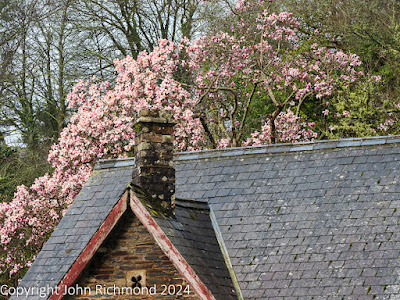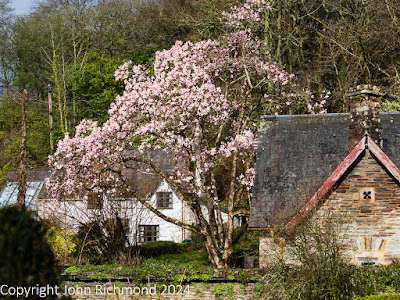Carrying unnecessary weight?
There are times I wonder why I bother to carry around a bag full with four lenses and a 1.4x teleconverter and then, having got back to base, realise I've only used one of them. Wouldn't I be better off leaving the surplus in the car and saving my self the burden of carrying the rest? After all, there are plenty of advocates of going out with just a camera and single lens, often a prime, and shooting only what worked with that combination.
I recently found myself in that position on one of my regular visits to The Garden House. And it was not with my 12-40mm f2.8 Pro or the 60mm macro and 9mm f1.7 - though they were in the bag - but with the 40-150mm f2.8 Pro, hardly the first choice most people would think of for a single camera lens combination in a garden setting.
So why did I end up taking all of my shots with this combination?
To produce reults like this:
Magnolia cambellii behind the buildings housing the garage and bothy. I needed to stand back amd use the lens at 150mm to get the angle and perspective right. Here's another shot, this time at the 40mm end of the zoom range:
The foreshortened perspective of a telephoto lens gives a more natural look to the image. Here's another example, also at 40mm:
The juxtaposition of the yellow winter branches of a weeping willow against the thatch of the old barn and the out of focus hedge in front is, I feel, very effective.
One of the shots I'd planned to get was of Narcissus cyclamineus growing beside a stream in the garden. I knew I'd have to focus stack to get a good depth of field and that there was only one side I could shoot from to get the view I wanted and, again, that needed the long zoom, this time at 70mm.
Although I have permission to go into the beds if necessary I try and avoid it. And for plants deep in the borders there is often no alternative but to use a long lens. In my Canon past that would have been the Sigma 180mm macro but now the 40-150mm serves the same purpose. This is Narcissus 'Jack Snipe' in the middle of a deep border.
One of the reasons for usiing a long lens in flower photography is to produce a nicely blurred background, exploiting the drop off in depth of field behind the subject. Easy enough when the background is far distant as with this 150mm f5 shot of Magnolia 'Kim Kunso'...
...rather harder when the background is closer. That's where focus stacking comes in, opening the aperture to get as much background blur as possible. This Bergenia 'Pink Ice at 150mm, focus stacked with all images shot at f3.5.
So why didn't I use any of my other lenses? I didn't need to. The Olympus 40-150mm f2.8 Pro did everythiing I set out to do on that day. But on another day I'll be swopping lenses like crazy to get the shots that fit that situation. Looks like I'll have to grin and bear the weight.





















